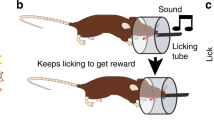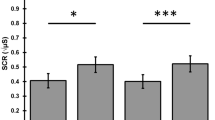Abstract
Cortical steady-potential shifts obtained from nonpolarizing electrodes chronically implanted in freely moving cats and rats reveal cortical activation related to urgency of response to unconditional and conditional stimuli. Such shifts appear relatively independent of activation in the rhythmic electrocorticogram and are related to higher levels of activation. Shifting is found to be modulated by drive and level of learning, suggesting a correlation with the proposed reaction potential of Hull. Both approach and avoidance “urgency” are reflected in the onset slope and amplitude of SP shifts in a manner suggesting modulation of cortical activation by the effects of behavioral regulation of stimulus conditions.
Similar content being viewed by others
References
Caspers, H.: Relations of steady potential shifts in the cortex to the wakefulnesssleep spectrum. In M. A. B. Brazier (Ed.)Brain Function, Number 1, pp. 177–213. Berkeley and Los Angeles, Calif., University of California Press, 1963.
Cohen, J., and Walter, W. G.: The interaction of responses in the brain to semantic stimuli.Psychophysiology,2:187, 1966.
Creutzfeld, O. D., Fromm, G. H., and Kapp, H.: Influence of transcortical d-c currents on cortical neuronal activity.Experimental Neurology,5:436–452, 1962.
Durkovic, R. G., and Cohen, D. H.: DC potential activity in a nervous system lacking neocortex; the pigeon telencephalon.Anat. Rec.,154:341 (abstract), 1966.
Gumnit, R.: DC potential changes from auditory cortex of cat.J. Neurophysiol.,23:667–675, 1960.
Hull, C. L.: Essentials of Behavior. New Haven, Conn.: Yale University Press, 1951.
Jung, R.: Discussion of “Brief Survey of Direct Current Potentials of the Cortex” by J. L. O'Leary. In G. Moruzzi (Ed.)Progress in Brain Research,1:264–265. Amsterdam, Elsevier Publishing Co., 1963.
Lickey, M. E., and Fox, S. S.: Localization and habituation of sensory evoked DC responses in cat cortex.Experimental Neurology,15:437–454, 1966.
Low, M. D., Borda, R. P., Frost, J. D., and Kellaway, P.: Surface negative, slow-potential shift associated with conditioning in man.Neurology,16: 771–782, 1966.
Morrell, F.: Effect of anodal polarization on the firing pattern of single cortical cells.Annals of N. Y. Acad. of Sciences,92:860–876, 1961.
Morrell, F., and Naitoh, P.: Effect of cortical polarization on a conditioned avoidance response.Experimental Neurology,6:507–523, 1962.
O'Leary, J. L., and Goldring, S.: DC potentials of the brain.Physiological Reviews,44:91–125, 1964.
Rowland, V.: Electrographic responses in sleeping conditioned animals. In G. E. W. Wolstenholme and M. O'Connor (Eds.) Ciba Foundation Symposium on the Nature of Sleep. London, pp. 284–304, 1961.
Rowland, V., and Goldstone, M.: Appetitively conditioned and drive-related bioelectric baseline shift in cat cortex.Electroencephalog. clin. Neurophysiol.,15:474–485, 1963.
Sommer-Smith, J. A., Galeano, C., Piñeyrúa, M., Roig, J. A., and Segundo, J. P.: Tone cessation as conditioned signal.Electroencephalog. clin. Neurophysiol.,14:869–877, 1962.
Terzuolo, C. A., and Bullock, T. H.: Measurement of imposed voltage gradient adequate to modulate neuronal firing.Proc. Natl. Acad. Sci. U. S.,42: 687–694, 1956.
Walter, W. G., Cooper, R., Aldridge, V. J., McCallum, W. C., and Winter, A. L.: Contingent negative variation: an electric sign of sensori-motor association and expectancy in the human brain.Nature,203:380, 1964.
Wurtz, R. H.: Steady potential shifts during arousal and deep sleep in the cat.Electroencephalog. clin. Neurophysiol.,18:649–662, 1965.
Author information
Authors and Affiliations
Additional information
Research supported by National Institute of Mental Health, Grants MH 05439 and MH 4731.
Awarded the Pavlovian Medal at the Harvard Meeting of the Pavlovian Society, February 11, 1966.
Rights and permissions
About this article
Cite this article
Rowland, V., Bradley, H., School, P. et al. Cortical steady-potential shifts in conditioning. Conditional Reflex 2, 3–22 (1967). https://doi.org/10.1007/BF03034092
Issue Date:
DOI: https://doi.org/10.1007/BF03034092




